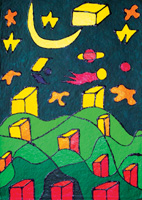|
|
|
 |
 |
Michele Berton nasce a Padova nel 1954; la lascia presto, prima alla volta di Roma e poi di Milano. Nel 1976 abbraccia il Buddismo, si trasferisce a Firenze e si iscrive alla facoltà di lettere moderne (si laurea con una tesi intitolata "Immagini della notte nel Decameron"). Nel frattempo, stringe un sodalizio con il pittore Martin Bradley, che sarà sua guida fino al 1984 e, insieme al maestro Miyashita, studia e pratica l’arte della calligrafia giapponese. Torna a vivere a Milano, dove ottiene anche un Master in Comunicazione d'Impresa. L'espressione artistica si compendia con un'intensa attività di docenza presso istituti di prestigio (Accademia Europea Arti e Media di Milano e di Novara, Accademia di Belle Arti di Brera, Centro Italiano Studio Sviluppo Psicoterapia a Breve Termine di Padova, Accademia Carrara di Bergamo), con corsi incentrati su teoria della percezione e psicologia della forma, sulla Diagnostica Luscher con approfondimento della teoria del colore ma anche sulla chimica del colore e su cromatologia e psicologia della visione. Dal 1979 a oggi partecipa a numerose mostre personali e collettive; le ultime in ordine di tempo sono "Troni", "Umanidi", "Vegetalidi", "Praeesepium" e "Fiori" (Galleria Quintocortile di Milano).
Hanno detto di lui
[…] Nella pittura di Berton, tutte le forme e nuclei figurali che, col concorso delle mie fantasie, sono suscettibili di raffigurare immagini umane, vegetali o animali, fluiscono dal colore che moltiplica le sue linee viventi; non rispecchiano la realtà, né sono progettate del tutto a priori dall’artista. È l’azione del dipingere che crea le forme: qui azione e forma sono la stessa cosa. Così è nella materia vivente, dove osservo il formarsi delle cellule per origine di un’azione misteriosa, la vita. L’arte non ha misteri, però è proprio questo il modo vitale, che chiamerei una forma di astrazione biologica, con cui procede la libera plasticità cromatica delle sue pitture.
A me pare che la pittura di Berton sia come una forma di vita che interroga un’altra forma di vita.
È un punto che considero capitale per lo sviluppo dell’arte dopo il moderno, domandarsi una volta ancora: cos’è la vita? Esistono tra noi forme sconosciute di vita che non consideriamo tali? E l’arte, che pure resta largamente inanimata, fa parte anch’essa dei mondi animati? […] intravedo opere d’arte che stanno riaprendo tali questioni […] ed è di questa tendenza per ora innominata che Berton fa parte col suo proliferante rituale pittorico. Non solo i suoi quadri favoriscono la nostra concentrazione mentale, come fanno i mandala orientali. Direi che essi funzionano un po’ come certi antichi dispositivi oracolari - penso alla Sfinge e pure all’I ching cinese - dove gli enigmi venivano sciolti, non dalle risposte, ma dalla giustezza delle domande continuamente modificate. Sinuosi come i pensieri o i dubbi, i suoi placidi flussi oracolari servono anche ad irrigare qualche balenante intuizione.
Tommaso Trini
Michele Berton was born in Padua in 1954; he was soon to leave it first for Rome and then for Milan. In 1976 he became involved in Buddhism, moved to Florence and enrolled in the faculty of modern literature (he passed his degree with a thesis entitled “images of a night of Decameron”). Meanwhile, he encountered and formed a firm friendship with the painter Martin Bradley, who was to be his guide up to 1984, while with master Miyashita he studied and practised the art of Japanese calligraphy. Subsequently he returned to Milan, where he attained a master in Company Communication.
His artistic activities have been accompanied by intense teaching activity in prestigious institutes (Accademia Europea Arti e Media, Milan and Novara; Brera Art Academy, Milan; Centro Italiano Studio Sviluppo Psicoterapia a Breve Termine, Padua; Accademia Carrara, Bergamo), with courses centred on the theory of perception and psychology of form, and on Luscher’s diagnostics, going into color theory but also into the chemistry of color and the chromatology and psychology of vision.
From 1979 to this day he has held numerous one-man and collective shows; the most recent being "Troni", "Umanidi", "Vegetalidi", "Praeesepium" and "Fiori" (Galleria Quintocortile - Milan).
It has been said of him
[…] in Berton’s painting all the figure like shapes and nuclei that, with the aid of my imagination, go to depict human, organic or animal images, flow from the color that multiplies their living forms; they do not reflect reality, nor are they entirely planned beforehand by the artist. It is the action of painting that creates the shapes: here action and shape are the same thing. The same goes for living material, where I observe the forming of cells originating from a mysterious action, life. Art does not have mysteries, though it is through this very vital mode, that I would call a form of biological abstraction, that Berton proceeds in the free chromatic forming of his painting.
To me it appears that Berton’s painting is a form of life that questions another form of life.
A point that I consider capital to the development of art subsequent to modern art, to once again ask oneself: what is life? Do forms of life exist around us that we do not consider as such? And art, that is for the most inanimate, is it also part of animated worlds? […] Berton’s paintings allow a glimpse of works of art that are again opening up these questions [… ] he being part of this for now unnamed movement, what with his proliferant painterly ritual. Not only do his paintings focus our mental concentration, in the way the oriental mandalas do. I would say that they work a bit like certain ancient oracular devices - the Sphinx and the Chinese I Ching spring to mind - where the enigmas were solved not by answers, but by the rightness of continuously changing questions. Sinuous like thoughts or doubts, his placid oracular flows also help to irrigate flashes of intuition. Tommaso Trini
|
|
|

Pacco sulla Luna
2004, acrilico su carta di cotone fatta a mano
2004, acrilic on handmade cotton paper.
|